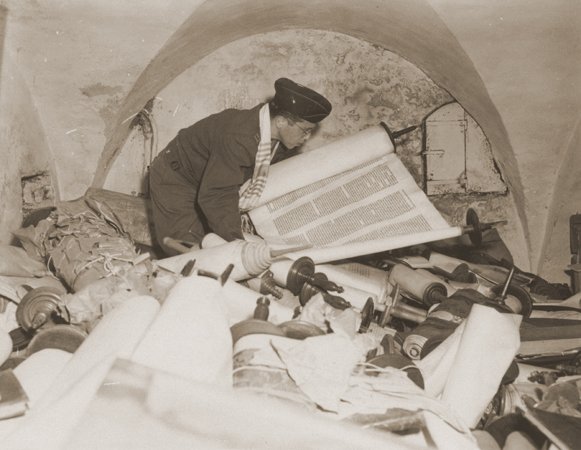About This Website
With support from the Conference on Jewish Material Claims Against Germany (Claims Conference), the United States Holocaust Memorial Museum (USHMM) has over the past decades brought together microform records of the Holocaust from archives all over the world. At the Washington Conference on Holocaust-Era Assets co-hosted in 1998 by the USHMM with the U.S. Department of State, attention turned to the importance of archival records in understanding the plunder of art and other cultural property by the Nazis and their allies. Subsequently at a seminar presentation at the Museum in February 2000, Patricia Kennedy Grimsted made an appeal for a virtual compendium of the widely dispersed records of one of the most important Nazi cultural looting agencies, the Einsatzstab Reichsleiter Rosenberg (ERR). This idea was discussed with interest by delegates from many countries later that year at the Vilnius International Forum on Holocaust-Era Looted Cultural Assets in October, 2000, where Dr. Grimsted suggested that a model project would be to digitize the registration card files produced by the ERR of art taken from French Jewish collections and held by the National Archives of the United States and to bring them together with the ERR photographs of those same artworks held by the Federal Archives of Germany (Bundesarchiv). During the next few years, Dr. Grimsted continued to investigate the locations of the scattered ERR files and completed an article on patterns of ERR library and archival plunder published in 2004 in the Museum’s journal Holocaust and Genocide Studies, followed by a research note the following year surveying the dispersed ERR records that have survived in many countries.
At the same time, the Claims Conference and the World Jewish Restitution Organization (WJRO) began a comprehensive program to assist the further restitution of Jewish-owned art and cultural property lost and plundered during the Holocaust. Unlike other areas of restitution, there had been no large-scale attempt to determine the full scope of cultural property seized by the Nazis and their allies, including items that had not been repatriated, or if repatriated, had not been restituted to original owners or heirs. Instead, following the Washington Conference on Holocaust-Era Assets in 1998, the focus was limited to checking the provenance of current museum collections and on claims made by individual survivors and heirs of owners. In light of all this, the Claims Conference aimed to reconstruct the historical-archival record so as (1) to develop listings of what was plundered by the Nazis and their allies; (2) to assemble listings of cultural property known to have been repatriated and restituted; and thereby (3) to produce net listings of outstanding items of cultural property still to be returned. (Information regarding the Claims Conference/WJRO Looted Art and Cultural Property Initiative may be found at http://art.claimscon.org/).
The Claims Conference has therefore undertaken to support four major activities in regard to the records of the ERR:
First has been the online publication of Dr. Grimsted’s ERR Archival Guide, a compendium, now revised as Reconstructing the Record of Nazi Cultural Plunder: A Guide to the Dispersed Archives of the Einsatzstab Reichsleiter Rosenberg (ERR) and the Postwar Retrieval of ERR Loot, presented on this website at https://www.errproject.org/guide.php.
Second has been the imaging of the ERR files in archives in Kyiv, Moscow, Vilnius, Berlin, Koblenz, Amsterdam, Paris, New York, and Washington with a view to making more ERR files publicly available online.
Third has been the joint creation with the U.S. Holocaust Memorial Museum of this Database of Art Objects at the Jeu de Paume in Paris, France, between the fall of 1940 and early August 1944 (Marc Masurovsky, project director).
Fourth, is a section devoted to ERR-Looted Libraries at https://www.errproject.org/looted_libraries.php with creation of webpages presenting ERR library-seizure lists from France, Belgium, and the Netherlands, with original accounts of ERR patterns of seizure, and charts of priority private victims.
This page last updated 2020-03-17

Chaplain Samuel Blinder examines one of the Torah scrolls stolen by the Einsatzstab Rosenberg and stored in the basement of the Institut fuer Juedische Erforschung (Institute for Research into the Jewish Question) in Frankfurt am Main
United States Holocaust Memorial Museum, courtesy of National Archives and Records Administration, College Park

